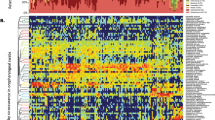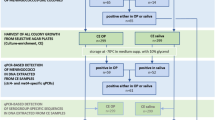Abstract
PREVIOUS reports1–3 have indicated that most, if not all, of the carbohydrate components of the mixture of glycoproteins as they exist as saliva in the human mouth are labile and are released by induced enzymes of bacterial origin. One of these enzymes—neuraminidase or sialidase—is of particular interest because the loss of sialic acid from saliva causes some of the glycoprotein components to precipitate out of solution, and this reaction may be an important factor responsible for the formation of dental plaque on the teeth. The loss of the other carbohydrate components (three hexoses, two hexosamines and fucose) must influence the calcium binding capacities of the residual proteins and this reaction must also be of significance in the formation of both dental plaque and calculus. Dental plaque has already been shown to bind more calcium than does an equivalent amount of salivary protein4. Neuraminidase is also of interest in other fields, where it has been shown, for example, to be the receptor destroying enzyme of myxovirus to erythrocytes5 and its presence could also be responsible for markedly changing the physical characteristics of mucins throughout the body during certain disease processes.
This is a preview of subscription content, access via your institution
Access options
Subscribe to this journal
Receive 51 print issues and online access
$199.00 per year
only $3.90 per issue
Buy this article
- Purchase on Springer Link
- Instant access to full article PDF
Prices may be subject to local taxes which are calculated during checkout
Similar content being viewed by others
References
Leach, S. A., Nature, 199, 486 (1963).
Middleton, J. D., Nature, 202, 392 (1964).
Lench, S. A., and Critchley, P., Nature, 209, 506 (1964).
Dawes, C., and Jenkins, G. N., Arch. Oral Biol., 7, 161 (1962).
Gottschalk, A., Physiol Rev., 37, 66 (1957).
French, E. L., and Ada, G. L., J. Gen. Microbiol., 21, 550 (1959).
Barker, S. A., Pardoe, G. I., and Stacey, M., Protides of the Biological Fluids, 11, 284 (1963).
Warren, L., J. Biol. Chem., 234, 1972 (1959).
Leach, S. A., and Hayes, M. L., Caries Res. (in the press).
Burnett, G. W., and Scherp, M. W., Oral Microbiology and Infectious Disease (Wiliams and Wilkins, Baltimore, 1957).
Author information
Authors and Affiliations
Rights and permissions
About this article
Cite this article
LEACH, S., HAYES, M. Isolation in Pure Culture of Human Oral Organisms capable of producing Neuraminidase. Nature 216, 599–600 (1967). https://doi.org/10.1038/216599a0
Received:
Published:
Issue Date:
DOI: https://doi.org/10.1038/216599a0
This article is cited by
-
Association Between Pneumonia and Oral Care in Nursing Home Residents
Lung (2011)
-
Utilization of mucin by oral Streptococcus species
Antonie van Leeuwenhoek (1990)
Comments
By submitting a comment you agree to abide by our Terms and Community Guidelines. If you find something abusive or that does not comply with our terms or guidelines please flag it as inappropriate.



